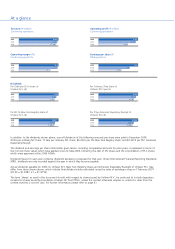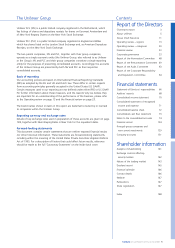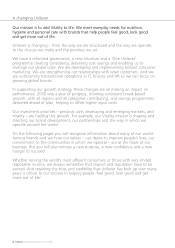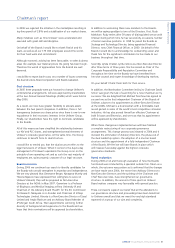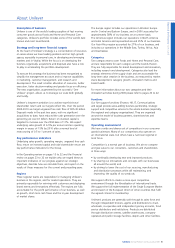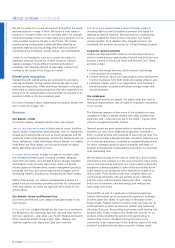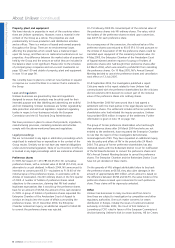Unilever 2006 Annual Report Download - page 10
Download and view the complete annual report
Please find page 10 of the 2006 Unilever annual report below. You can navigate through the pages in the report by either clicking on the pages listed below, or by using the keyword search tool below to find specific information within the annual report.
Unilever Annual Report and Accounts 2006 7
Report of the Directors (continued)
About Unilever (continued)
Unilever employees whose skills are honed in developing and
emerging (D&E) markets are reaching senior positions both at
home and abroad, and 20% of our top 123 managers are from
D&E regions. Andina/Central America, Argentina, Brazil, India,
Indonesia, Japan, Mexico, Pakistan, the Philippines and South
Africa all have either local nationals as their chairmen, or
chairmen from within the D&E regions. Furthermore, 39% of all
individuals on international secondment are from developing or
emerging countries.
Hindustan Lever, Unilever’s business in India, has a Personal
Vitality Programme which assesses individual employees’ body
mass, blood pressure, cholesterol and blood sugar levels. And
assistance is provided to those who have nutrition or health
issues, or exercise requirements. Although voluntary, over
10 000 employees have taken part so far and each will be
followed up annually to ensure they have every opportunity
to improve their health.
Strong, effective leadership is at the heart of our transformation
programme and is the key to sustaining high levels of business
performance. Our new global Standards of Leadership framework
clearly sets out the behaviours needed to align ‘hearts and minds’,
inspirepeople to achieve excellence in strategy execution and
develop the skills and capabilities we need for the future.
Maintaining health and fitness can be challenging for senior
managers in demanding roles. During 2006, several senior
leadership teams – including the Unilever Executive – took part
in a well-being programme. Each received their own individual
health and Vitality check, which was then used to design a
personal plan to enhance their habits and practices in physical
activity, nutrition and mental resilience. In 2007 a further ten
leadership teams are expected to participate in a well-being
programme.
Our total employee numbers over the last five years were as
follows:
Year end in thousands 2006 2005 2004 2003 2002
Europe 44 49 52 55 60
The Americas 45 47 47 50 53
Asia Africa 90 110 124 129 134
Total 179 206 223 234 247
Of the overall reduction in numbers during 2006 of 27 000, the
sale of a plantations business in India accounted for a reduction
of 18 000. A further 3 000 resulted from the sale of the majority
of our European frozen foods businesses, with the remainder of
the reduction arising from other business disposals and a range
of restructuring projects.
Included in the total reported numbers for 2006 were 26 000
part-time or seasonal employees (2005: 33 000).
Diversity
Diversity in Unilever is about inclusion, embracing differences,
creating possibilities and growing together for better business
performance. We embrace diversity in our workforce; this means
giving full and fair consideration to all applicants and continuing
development to all employees, regardless of gender, nationality,
race, creed, disability, style or sexuality. Diversity plays a vital role
in ensuring we understand consumers’ needs.
The commitment to diversity is set right at the top of our
business. An important legacy of our Chairman, Antony
Burgmans, is that he is leaving the most diverse Unilever Board in
our history. Going forward, Group Chief Executive Patrick Cescau
will lead our global diversity board that will drive the diversity
strategy within the business.
Unilever is one of the world’s most culturally diverse companies
with 24 different nationalities represented among our top 123
managers worldwide.
In 2006 we focused on practical diversity initiatives. These
included the quarterly measurement and tracking of diversity
against objectives and the integration of our diversity agenda
into our people processes.
Gender continues to be the primary focus of our diversity strategy,
as well as a way of improving business performance. Between
2000 and 2006, we have increased our female management
profile from 25% to 33% and most of our senior leadership
teams, such as Foods, Europe, The Americas and human
resources include female leaders.
Information technology
Unilever IT is a global function headed by the Global Chief
Information Officer with a strategy to deliver simpler, more cost
effective IT solutions to support the business. Common
technology framework and standards for architecture, key
technologies, process, information and services, allow Unilever
to leverage its scale. For example, this approach is supporting
the integration of our businesses in each country under the ‘One
Unilever’ programme, as well as the setting up of regional shared
service centres for ‘back-office’ operations, which in some cases
are being outsourced.
The development of ‘destination IT architecture’ is another
example of simplifying and leveraging scale. The destination IT
architecture is essentially a long-term view on the IT application
and technology landscape for Unilever.This also fundamentally
changes the way IT works with the business.
Unilever partners with a few major suppliers to develop the
minimum number of non-overlapping systems needed to deliver
the business objectives. This promotes radical simplification with
flexibility and agility,faster implementation and reduced costs.
Intellectual property
Wehave a large portfolio of patents and trademarks, and we
conduct some of our operations under licences which are based
on patents or trademarks owned or controlled by others. We are
not dependent on any one patent or group of patents. We use
our best efforts to protect our brands and technology.



